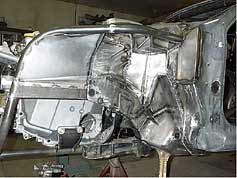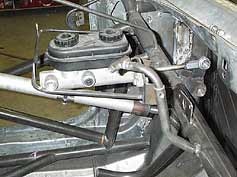|

PART TWO
Click here to read part one
By Wayne Scraba
Photos courtesy GM/MPR
1/7/05
 |
 |
| In a rear wheel
drive application, frame rails are moved inwards and
tubs are fabricated. That’s no big secret. But
in a FWD car, restrictions by both the Rulebook and
the car layout determine what can and cannot be done.
According to the Rulebook, parts of the OEM strut tower
must remain, but as you can see, in order to fit the
rolling stock, considerable surgery in and around the
tower is mandatory. The reason, of course, is both
structural and the need for rubber room. |
Suspension, Front: “Upper mounting point
for strut assemblies must be in the factory location. Front
and rear sides of strut tower may be “notched” for
tire clearance and area must be refinished with minimum .024-inch
steel. Full wheel tubs prohibited. Roll-bar tubing may run
across top of strut tower and attach to frame horn. Adjustable
caster/camber pillowball mounts are permitted. Lower control
arm may be strengthened provided factory-mounting points
to chassis are maintained. Aftermarket or fabricated lower
control arms permitted; must use original mounting points.
Lower mounting point for strut assembly may be modified for
improved caster or camber. Strut tower braces, lower tie
bars, sway bars, and limit straps permitted. Traction bars/devices
permitted; must be bolt on ONLY. Final decision rests with
NHRA Technical Services.”
 |
 |
| Since everything
is so densely packed in the engine compartment, the
solution in this case is to mount the master cylinder
under the dash. The master cylinder is perched on a
bracket welded to the roll cage brace and activated
by a crafty bell crank arrangement. |
As you can see, there’s more “stock” here
than first meets the eye. Sure the cars are heavily reworked
(and they have to be to contain the HP they’re producing),
but much of the factory geometry must remain as produced.
When you’re examining these Rules, keep in mind that
the chassis builder is not only dealing with driving the
front of the car, he’s also faced with steering and
the previously mentioned packaging requirements.

|
